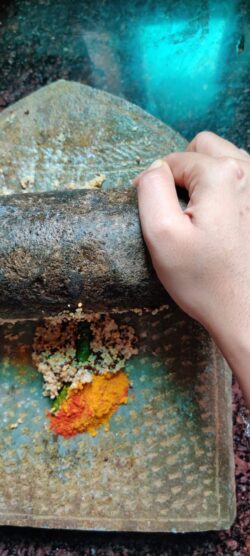Shorshe Bata, Bata Moshla and Sheel Nora

It amazing how reading a well researched piece helps us organize our thoughts into a coherent chain. I say this because fresh on my mind is Rushina’s post about use of spices in Indian cooking.
Bengalis are legendary for their shorshe bata (wet ground mustard) but it is as prevalent in Odia cooking and fairly prominent in Bihar and Assam. As much as Bengalis and Odia spar over mustard paste, the truth is they are dissimilar in their treatment. Bengalis use shorshe in all its pungency, in most cases it being ground just with salt and green chilli to counter the slight bitterness, much like Axomiyas.
The Bengali mustard is often cooked with onions, coconut, and other spices but seldom ground with any other spice, except for the mild posto (poppy seed). Interestingly, there are differences between the Bangal and Ghoti shorshe batas- a Bangal shorshe bata will have zero to minimal posto, higher proportion of pungent red mustard to yellow mustard. Whereas, in Odia cooking, mustard is most commonly ground with cumin, dry red chilli and garlic; a striking similarity with the Bihari mustard paste. It is a similarity that is seldom spoken about, and I am sure is one of the many between the two cuisines owing to geographic proximity and Kalinga’s long trade, war and Buddhist relationship with Patliputra.
Shorshe, besides gorom moshla and posto has distinct refinement in taste and texture when ground on sheel nora. An electronic grinder won’t cut it. Just like a fine connoisseur will grind chilli, turmeric and cumin powders, or aada-jeere (ginger-cumin) on a sheel nora for a finer, smoother machher jhol or a dalna. Especially if you want to add ginger paste towards end of cooking a niramish (vegetarian) dalna.
However, sheel noras are difficult to use in modern houses. They aren’t made for tiled floors and high counter tops don’t optimise upper body strength. Also lifting them up and down isn’t the easiest thing to do. We have designed houses to fade them out!
Btw, did you know there is a belief that the person who lays the sheel-nora should also wash and put it away?

